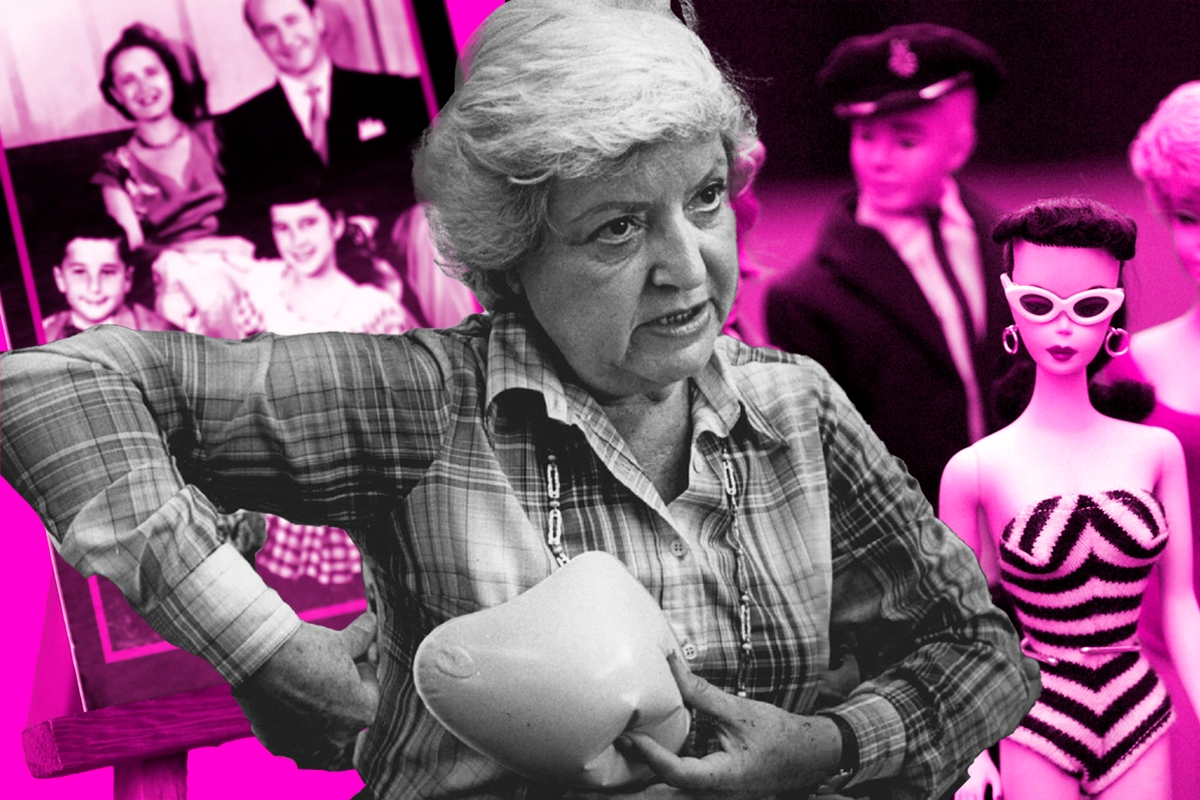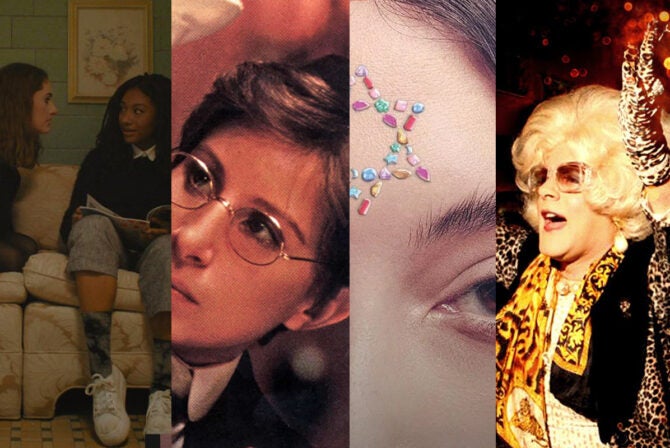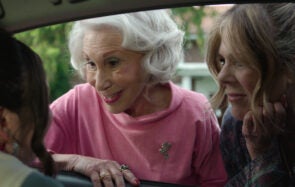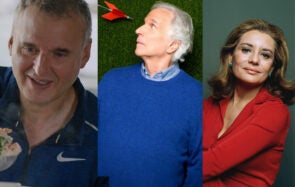Ruth Handler, the Jewish inventor of Barbie, was watching her daughter Barbara one day. Like so many little girls across the world, Barbara was using paper dolls to play an elaborate game of pretending to be a grown up.
It was that moment — and an encounter with a gag doll of a prostitute on a family vacation in Switzerland (yes, really!) — that inspired the creation of what remains one of the most iconic and globally recognized kids’ toys, and the subject of the upcoming movie of the summer: the Barbie doll.
In the new “Barbie” movie, directed by Greta Gerwig, Handler, who died of colon cancer in 2002, is played by another Jewish icon: Rhea Perlman. She is reunited with the doll that changed her life at the beach, in a Michaelangelo-esque scene in which the creator touches their creation. “Humans have only one ending. Ideas live forever,” Handler tells Barbie, played by Margot Robbie.
It’s true. Many of us don’t know Handler’s name, but almost everybody knows Barbie.
It’s strange to think of Barbie as a doll that righted a sexist wrong — with her thin limbs and ads that touted her petite figure — yet at the time, most toy companies catered to the imagination of boys. Ruth Handler created a doll that was meant to let little girls imagine a future that wasn’t solely limited to being a mother, but a working woman. She was a nurse. An astronaut. A teacher. And in the years since her invention, she’s never gotten married, never had kids.
“Barbie pointed the way out of the kitchen,” said the author of “Forever Barbie,” M.G. Lord.
And in a way, Barbie was a lot like her creator. “I loved my children, but I wasn’t suited to taking care of a home,” Handler once said.
It took three years for Barbie to come to fruition — the doll was launched in 1959, with a fashionable and somewhat risqué striped white and black swimsuit, hoop earrings and heavy eye makeup. Nobody really believed in Ruth’s vision for the doll, including her own husband, the co-founder of Mattel, Elliot Handler. “No mother is ever going to buy her daughter a doll with breasts,” he reportedly told her. But Ruth had a lifetime of making impossible things happen for herself, and as her daughter, Barbara, said in an interview, “When she thought something was important, she did not take no for an answer.”
Handler was born Ruth Mosko in 1916. The youngest of 10 children, her parents were Jewish immigrants. They escaped antisemitism and forced conscription and built a life in Denver, Colorado, where her father, Jacob, who changed the family name from Moskowitz to Mosko, worked on the railway. Jewish life in Denver wasn’t idyllic — Ruth and her family experienced antisemitism, but they also made a life for themselves.
Handler spent much of her life working. “I needed to prove myself from the day I was born,” she once told Connie Chung.
She worked at the soda shop owned by her older sister, Sarah, who raised her like a parent, and in her brother’s law office. She dropped out of college in Denver at 19 and started working at Paramount studio as a stenographer while her husband went to art school. She then worked selling her husband’s light fixtures, then doll houses, and then, in 1945, she started running his toy company, Mattel, with him and Harold Matson, who later sold his shares to the Handlers. (Fun fact: a fictionalized version of Mattel’s current Jewish CEO, Ynon Kreiz, an Israel-American businessman who himself is married to an amazing Jewish woman, Anat Fabrikant, a former Israeli Olympian, is also in the movie, played by Will Ferrel.)
Ruth often said that her life had three chapters. In the first one, she did things “our way.” By our way, she meant hers and Elliot’s way. Their relationship, she said, was truly synergistic. They first fell in love in 1929, at a Bnai Brith dance in Denver when they were both 16. Her family reportedly didn’t want her to marry him — he wasn’t rich or connected. But Ruth never cared for what was expected of her. She proposed, and they got married in 1938.
Biographer Robin Gerber said that Mosko asked to change his very Jewish first name — Isadore — when they moved to Los Angeles because “she had felt the antisemitism at that time, in the 1930s, and she really felt that they’d be better off with a more Americanized name.”
Despite all that, Judaism was always a part of the Handlers’ lives. They helped found Temple Isaiah in Los Angeles. They gave to United Jewish Appeal and other Jewish causes. They are both buried in the Jewish Hillside Memorial Park and Mortuary in Los Angeles, next to Elliot’s Jewish mother, Freida, a Russian Jewish immigrant, and their son, Ken, who tragically died at age 50 in 1994.
And yet, more than anything, they were all-American. “Ruth really considered herself to be very assimilated in America,” Susan Shapiro told Kveller in 2019.
Elliot was soft-spoken, a dreamer, a perennial child, with an openness and imagination that led him to create dolls like Chatty Cathy and the Hot Wheels franchise. His daughter and granddaughter recall him drawing on tablecloths whenever they went to restaurants and happily playing with kids at every opportunity. In one video of the Handlers in their home, you can see Ruth lovingly admiring her husband’s art as she goes through their archive. “He has a tremendous sense of humor in his art,” she says with great affection.
If Elliot was a dreamer, Ruth was all action, all front of house. In the age of “Mad Men,” she was a woman who catapulted what still remains one of the biggest toy companies in the world into the heights of commercial success.
She was a marketing genius, understanding the power of children as consumers, a power that most parents know all too well. Handler paid an unprecedented $500,000 to be the sole sponsor of a new show called “Mickey Mouse Club.” It was a decision that put Mattel in front of so many children across the nation, and helped sell around 350,000 Barbie dolls in her first year of production. Three years later, Ken, Barbie’s best male friend, named after the Handlers’ youngest son, came along.
According to Barbara Handler and her daughter, Cheryl Segal, the Mattel factory in Hawthorne was a wonderland of diversity and inclusivity, where workers were welcome regardless of the “color of their skin or sexual orientation.” When the grandkids would visit (Ken had three kids with his high school sweetheart; Barbara had two) it felt like Willy Wonka’s factory.
But it wasn’t all perfect. In 1975, came the second, and arguably, the worst chapter of Ruth’s life, in which she was forced out of the company she and Elliot created. She was accused of allegedly falsifying earnings and sales, a dark chapter in the company’s history that’s alluded to in the movie. Ruth pled no contest, and her sentence was commuted into 500 hours of community service. The Handlers later sold their remaining shares in the company for $18 million.
That wasn’t the only controversy around Mattel and Barbie — to be fair, there are too many small and big ones to recount. The doll’s unrealistic figure has often been criticized. Her proportions are literally inhuman (it has been said that if Barbie were human, she would not be able to stand) and critics have warned that it could lead to negative body image and eating disorders in young kids. “Many women have a problem with their own bodies as they grow older. I can not believe that the doll causes that,” Ruth countered in one interview.
It’s true that Barbie isn’t the sole cause of women’s issues with their bodies — kids are way more likely to be influenced on these matters by other adults, from their own parents to the images they see in the media. But if Barbie was meant for girls to imagine their future, it was a future in which beauty equaled an impossible thinness. Mattel has tried to give us more body diversity from Barbie throughout the years, and the new movie, which was bankrolled by the toy company, has an incredibly diverse body representation as well.
Women’s bodies were an important recurrent theme of Handler’s life — specifically breasts. Her final entrepreneurial endeavor — the third and final chapter of her life, in which she did things her way — was founding the breast prothesis and accessory company Nearly Me in 1976. In 1970, while still working at Mattel, Handler was first diagnosed with breast cancer and had a partial mastectomy. It was traumatizing. “When I lost my breasts it was as if I lost my femininity,” she recounted. Existing prosthetics at the time didn’t help.
“When she went to a department store to get fitted, they were very abrupt, rude,” Barbara recalled in an interview with the New York Times. “She didn’t like the way she was being treated. And the product wasn’t decent.”
“They were designed by men who didn’t have to wear the damn thing,” Ruth accurately surmised in an interview.
And so, as someone who knew a little bit about making fake breasts already, she decided to open a company of her own. Its slogan? “The best man-made breast are made by a woman.”
The brilliant tagline wasn’t enough. Ruth went all out when it came to marketing her life-altering products. She went on TV and revealed her brassiere. She even allowed journalists and other women to touch them and feel their lifelike texture. It was a brazen, chutzpadik marketing feat, but one that exposed so many breast cancer survivors and fighters to products that significantly improved their quality of life. It was the work that meant the most to her.
Through her life’s work, Handler reminded us all that breasts may be what connect a woman to her femininity or womanhood, but they aren’t necessarily sexual. For Barbie, they were a way to signify adulthood. For Ruth, Nearly Me made her feel more herself at a time so fraught for her health. When she let men and women grope her prosthetics on TV, there was nothing suggestive about it. It was all about reaching out and empowering women and girls.
Barbie may have secured Handler’s place in history, but it didn’t win her any brownie points as a mom. According to an LA Times interview, both Barbara and Ken were resentful of their respective namesakes and never played with them. Barbara was too old to play with Barbies when the doll finally came out in 1959, and she didn’t like being constantly hounded with questions about the doll. Ken was, according to Handler, teased because of the doll’s apparent lack of genitalia as a kid. He was also not a fan of the kind of glitzy, vapid world the dolls inhabited.
Growing up, Barbara especially struggled to have a mom so different from her peers’. Still, she admired her mother. “She was always for the women to be successful and strong… it wasn’t like she was strong and not-feeling, or [would] walk over people, anyone in need she would go out of her way to help.”
“Much of me is very proud that my folks invented the doll,” Barbara once said. “I just wish I wasn’t attached to it.”
Like the doll she created, Ruth Handler was complex. She was both a feminist icon and a woman who unwittingly helped reinforce patriarchal beauty standards. She was someone who never forgot her Jewish roots and identity, but who was cautious about touting it for fear of antisemitism. She and her husband imagined an open, synergistic and inclusive workplace — one that they both ultimately had to leave behind because of their own wrongdoings or willful ignorance. She was an empowered working woman who made history, and yet who also was open about the fact that her own children didn’t really love how that kind of groundbreaking entrepreneurship affected their own lives. And she reinvented herself through a disease that ultimately killed her.
Ruth Handler may be a real symbol of the American dream — incredible, admirable, iconic, and a lot more complicated than we often imagine it to be. Life isn’t all Malibu dream houses, and this isn’t a Barbie world, after all.








